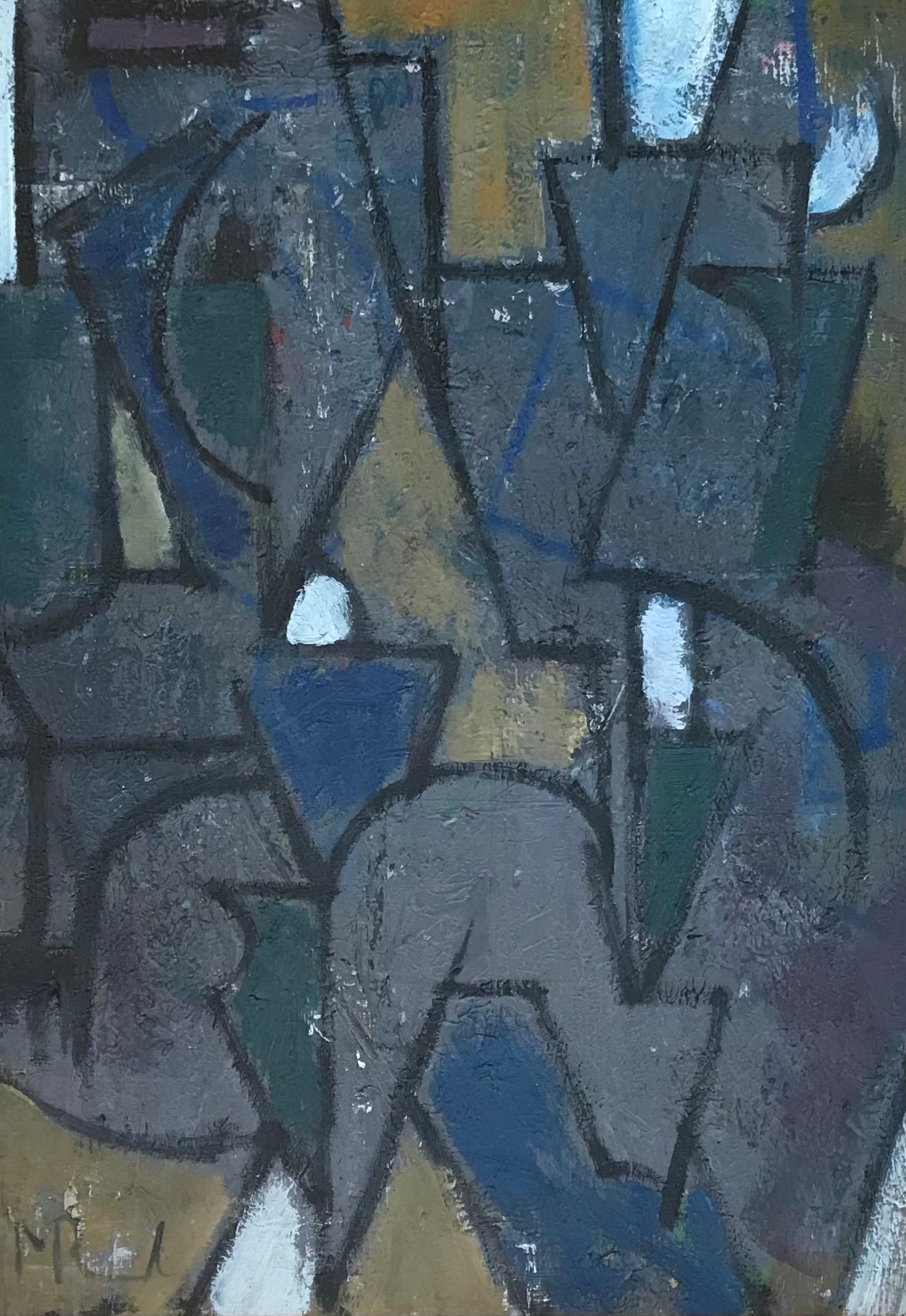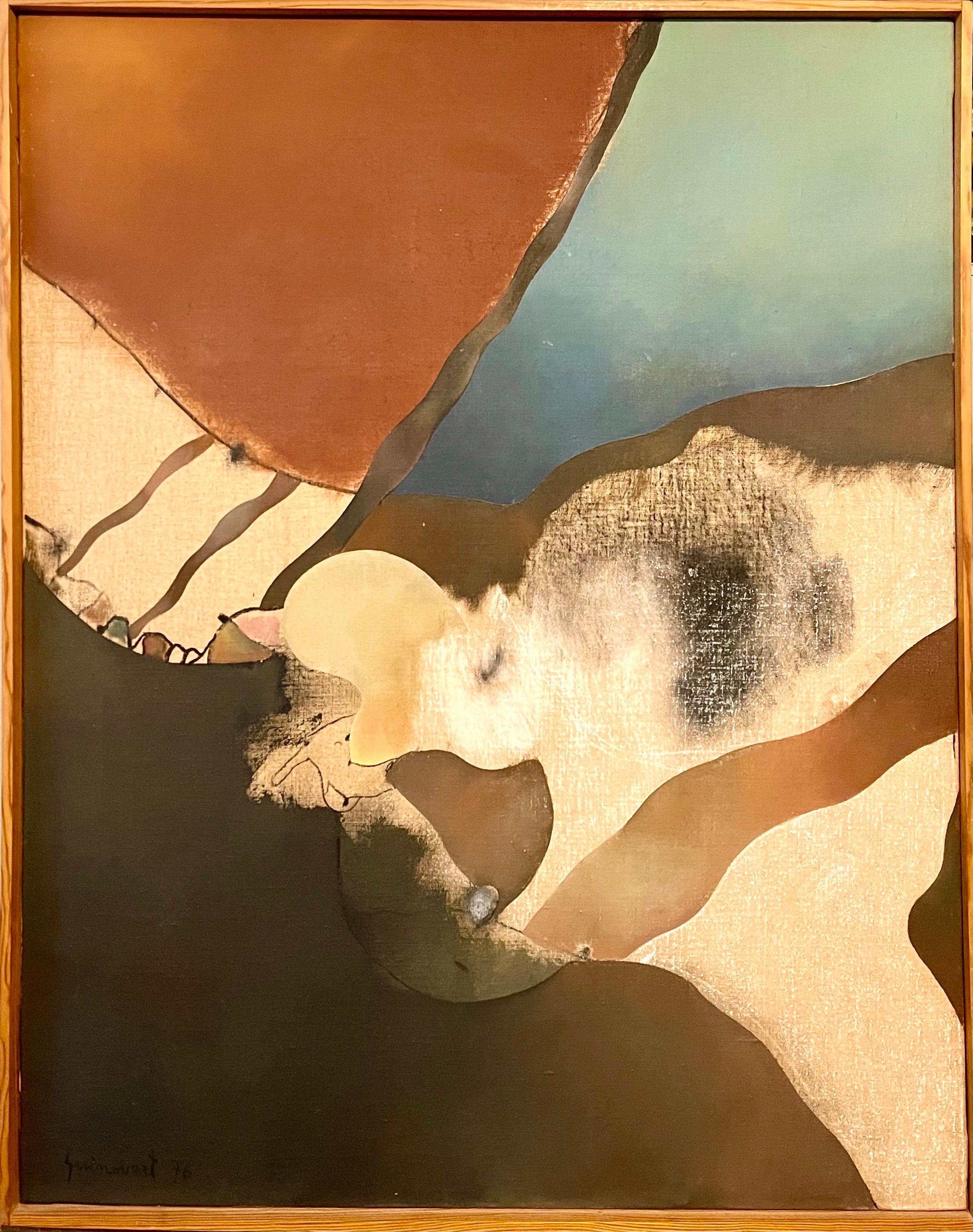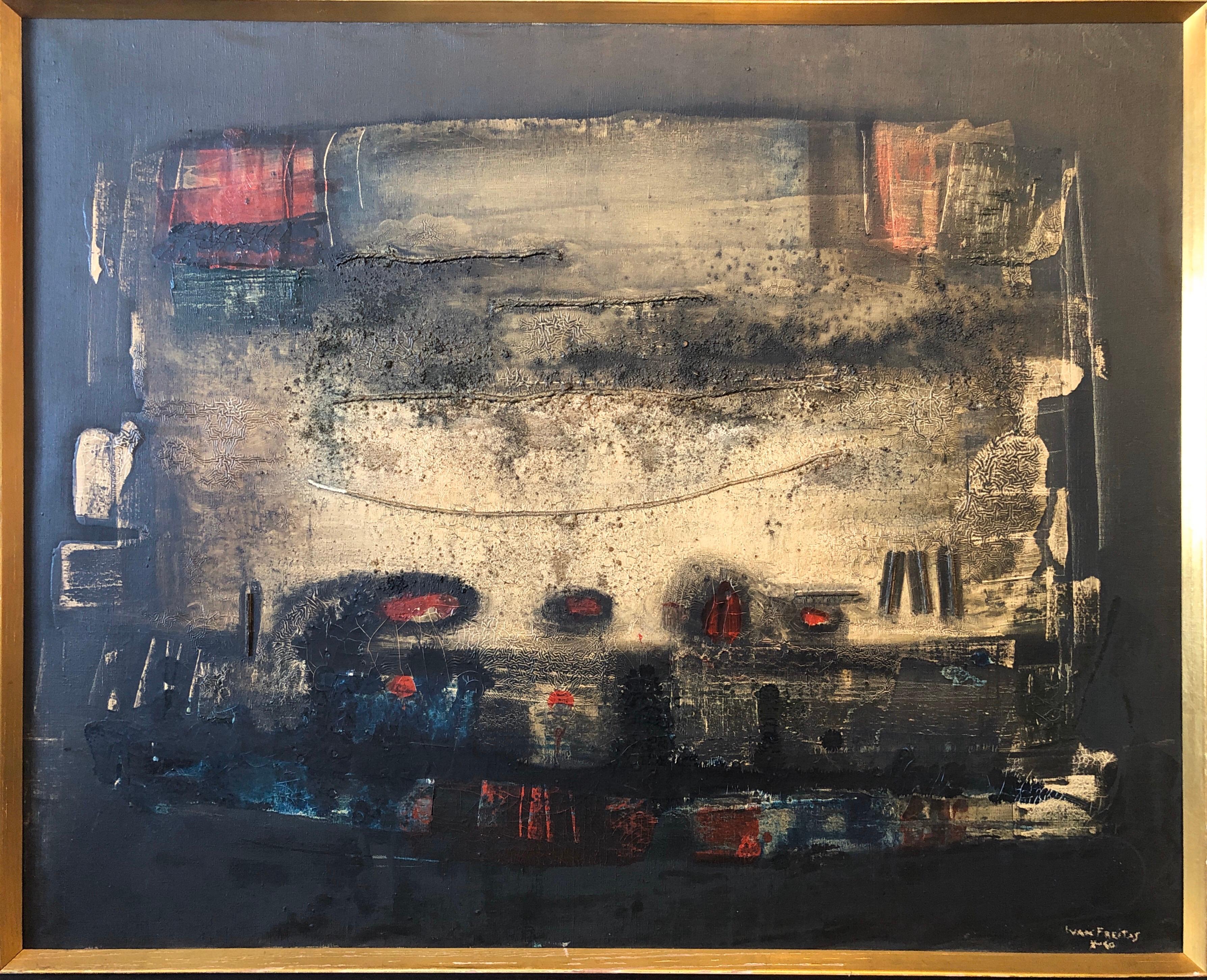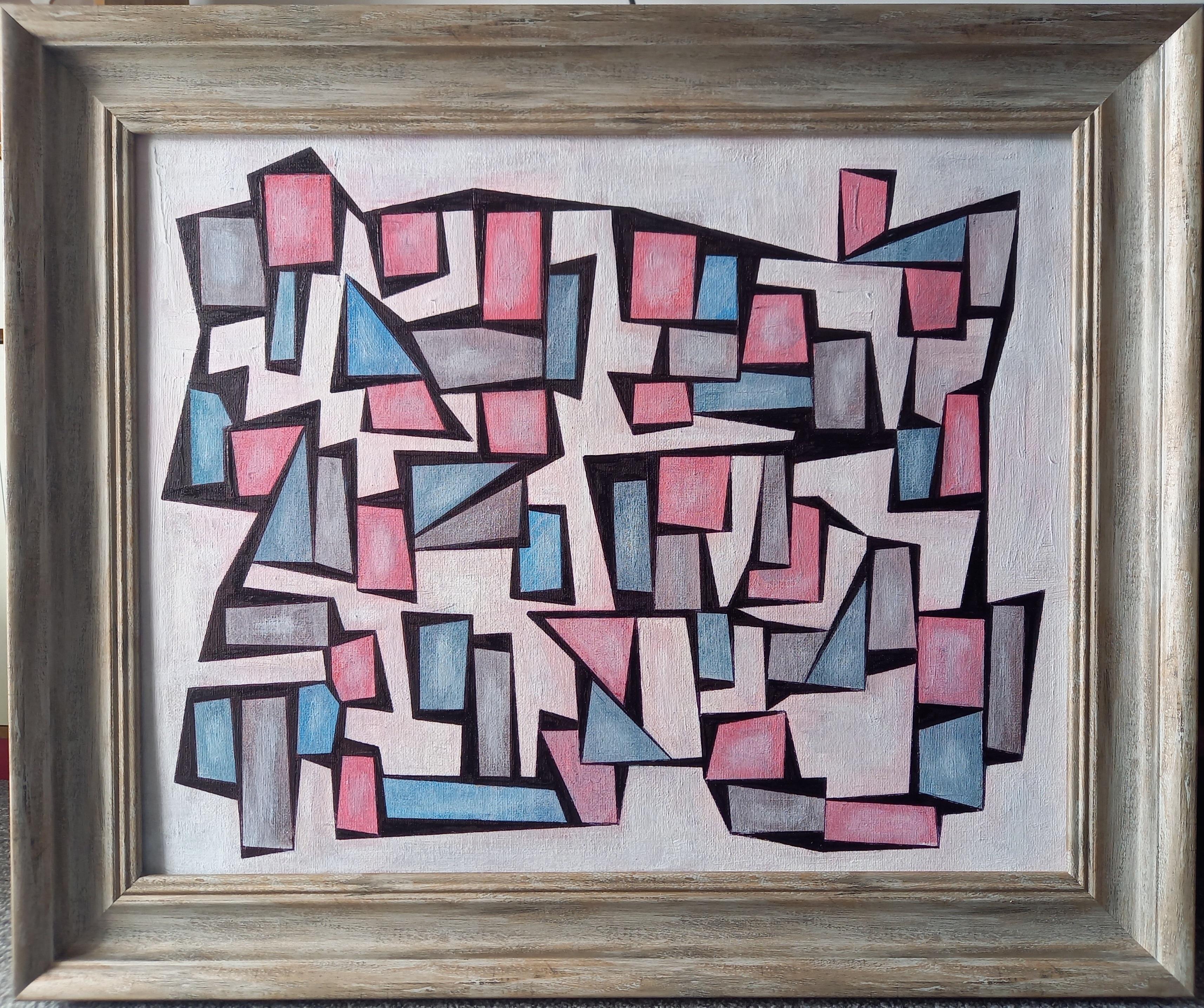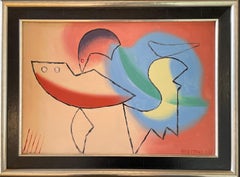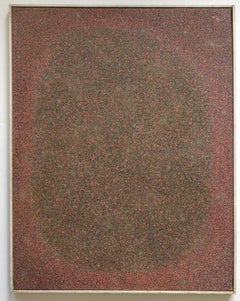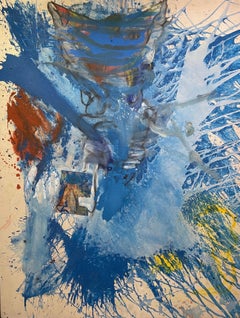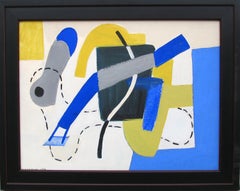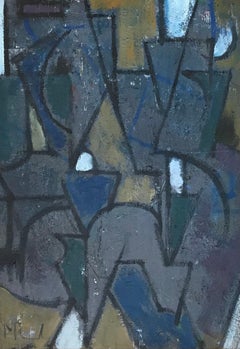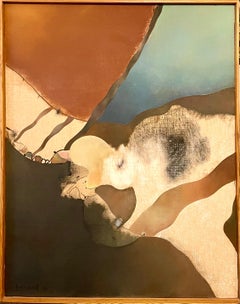Items Similar to Series 67 No.4 abstract oil painting by Jack Wolsky
Want more images or videos?
Request additional images or videos from the seller
1 of 12
Jack WolskySeries 67 No.4 abstract oil painting by Jack Wolsky1955
1955
$3,750
£2,845.76
€3,258.63
CA$5,329.01
A$5,799.98
CHF 3,044.94
MX$70,072.24
NOK 38,217.33
SEK 36,034.43
DKK 24,325.40
About the Item
Series 67, No. 4 (1955)
Oil on masonite
48" x 24 ½"
49" x 25 ¼" x 1 ¾" framed
About this artist: Jack Wolsky was born in 1930 in Rochester, New York.
He taught in the Department of Art at SUNY Brockport from 1959 to 1985, where he then became a Professor Emeritus in 1985.
During his time at SUNY Brockport, he was awarded many awards and honors including the Jurors’ Award – Rochester Finger Lakes Show in 1962, the Lillian Fairchild Award in 1970, the Outstanding Educators of America 1971 edition, Who’s Who in American Art 1976 (14th Edition), Chancellor’s Award for Excellence in Teaching in 1979, Rochester Chamber of Commerce Civic Award in Culture and Arts in 1999, Who’s Who in America in 2006, 2007, 2008, 2009, 2010, 2011 and 2012.
He was active in volunteering and being part of several boards. He was an Art Volunteer at the American Red Cross, Rochester Chapter and at the Jewish Home of Rochester. He was a board member for Friends of School of the Arts in Rochester, Temple B’rith Kodesh in Rochester, and the Rochester Area Hillel Foundation.
Jack influenced and shared his knowledge with many young artists. He was loving, kind and humble with an engaging personality, upbeat, friendly and always positive, often funny, and drew everyone to him. He was a real people magnet.
–from the Artist's 2023 Brighton Memorial Chapel obituary
About the Seller
5.0
Vetted Professional Seller
Every seller passes strict standards for authenticity and reliability
Established in 1973
1stDibs seller since 2023
13 sales on 1stDibs
Typical response time: <1 hour
- ShippingRetrieving quote...Shipping from: Hudson, NY
- Return Policy
Authenticity Guarantee
In the unlikely event there’s an issue with an item’s authenticity, contact us within 1 year for a full refund. DetailsMoney-Back Guarantee
If your item is not as described, is damaged in transit, or does not arrive, contact us within 7 days for a full refund. Details24-Hour Cancellation
You have a 24-hour grace period in which to reconsider your purchase, with no questions asked.Vetted Professional Sellers
Our world-class sellers must adhere to strict standards for service and quality, maintaining the integrity of our listings.Price-Match Guarantee
If you find that a seller listed the same item for a lower price elsewhere, we’ll match it.Trusted Global Delivery
Our best-in-class carrier network provides specialized shipping options worldwide, including custom delivery.More From This Seller
View All4-35 abstract oil painting by Charles Biederman
Located in Hudson, NY
Signed and dated "Biederman 4-35" lower right.
About this artist: Charles Joseph Biederman was a twentieth century abstract American artist best known for his constructivist, cubist...
Category
1930s Abstract Expressionist Abstract Paintings
Materials
Canvas, Oil
Untitled abstract oil painting by Elaine Wesley
By Elaine Wesley
Located in Hudson, NY
Signed verso with estate stamp "Estate of Elaine Wesley/1923-2007"
Canvas measures 30 ¾" x 24" and framed measures 31 ¾" x 25"
Category
1980s Abstract Abstract Paintings
Materials
Canvas, Oil
P.F.P. abstract oil collage by Bill Saylor
Located in Hudson, NY
P.F.P. (2011)
Oil on canvas with collage
Titled, signed and dated "P.F.P. / Bill Saylor / 2011" verso on canvas.
Exhibited 2017 in "Animal Farm" a group exhibition at The Brant Foun...
Category
2010s Abstract Abstract Paintings
Materials
Canvas, Mixed Media, Oil
Untitled Abstraction-008 casein tempera on board by Vaclav Vytlacil
By Vaclav Vytlacil
Located in Hudson, NY
Signed and dated "Vytlacil 38" lower left, and signed and dated verso.
Provenance: Estate of the artist #1602; Martin Diamond Fine Art
About this artist: Born in 1892 to Czechoslov...
Category
1930s Abstract Expressionist Abstract Paintings
Materials
Tempera, Casein, Board
Encaustic Abstract Untitled Painting 010 by Frederik Ottesen
Located in Hudson, NY
The bold texture of this artwork engages the viewer. The textures Ottesen created are not as apparent until seem from close up. A subtle stunner.
Framed this piece measures 29.25" ...
Category
1950s Abstract Expressionist Abstract Paintings
Materials
Canvas, Encaustic
Untitled-006 abstract painting by Fred Martin
By Fred Martin
Located in Hudson, NY
Exhibited:
2003 Oakland Museum of California "Fred Martin Retrospective"
A native Californian, Fred Martin was born in San Francisco in 1927, and received both his BA (1949) and MA (1954) from University of California, Berkley. At the San Francisco Art Institute Martin studied with Clyfford Still, Mark Rothko and David Park...
Category
1970s American Modern Abstract Paintings
Materials
Masonite, Pastel, Acrylic
You May Also Like
Abstract Composition - Oil on canvas 34x46 cm
Located in Geneva, CH
Work on canvas
Wooden frame with golden patina
56,5 x 43,5 x 3,5 cm
Monogram M.R
Category
Mid-20th Century Abstract Abstract Paintings
Materials
Oil
Composicion #23
Located in Milford, NH
A fine Mid Century vertical abstract expressionist oil painting by Panamanian artist Antonio Alvarado (b. 1938). Antonio studied under the figurative ...
Category
1960s Abstract Expressionist Abstract Paintings
Materials
Canvas, Oil
Mid Century Modern Abstract Oil Painting
Located in San Francisco, CA
Fabulous mystery midcentury abstract. It is oil on board measuring 60 inches wide by 20 high. Frame is 1/2 around. Painting is signed Kirstein. The artist was obviously very talented...
Category
Mid-20th Century Abstract Abstract Paintings
Materials
Oil
Abstract Spanish Catalan Oil Painting Josep Guinovart from Joan Prats Gallery
By Josep Guinovart Bertrán
Located in Surfside, FL
Josep Guinovart (1927 –2007) was a Spanish Catalan painter most famous for his informalist or abstract expressionist work.
In 1941, he began to work as a decorator. Three years later, he started his studies at the Escuela de Artes y Oficios de la Llotja (Art School of La Llotja) where he stayed until 1946.
He first exhibited his work in 1948 in Galerías Syla in Barcelona. In 1951, he produced his first engravings entitled 'Homage to Federico García Lorca'. Two years later, he was awarded a grant from the French Institute to study in Paris for nine months. Here he discovered the cubist works of Henri Matisse and Pablo Picasso and travelled to Belgium, Holland and Germany.
On his return to Barcelona and after a period working as an illustrator and set designer, around 1957 he began moving towards abstract art. His work is highly unconventional and usually on a large scale, using a wide range of materials, three-dimensional objects and organic substances such as eggshell, earth and straw.
In 1962, he illustrated a book of poetry entitled Posies by Joan Salvat-Papasseit for the Ariel Editorial. He won many accolades for his work throughout the 1970s and 80s, including Spain's National Award for Plastic Arts in 1982. In 1994, a museum foundation dedicated to his art was inaugurated in Agramunt, his mother's birthplace to which he always felt a special attachment.
In 2006 he designed the winery Mas Blanch i Jové in La Pobla de Cérvoles (Lleida) and created The Artists' Vineyard, a project intended to mix sculptures and other art works from different artists in the middle of a vineyard. The Artists' Vineyard was inaugurated after his death in 2010 with the unveiling of his sculpture The Countryside Organ: a music instrument, 6 meters height, for the wind to sing the vines. This winery also displays the 10.5 meters work In Vino Veritas...
Category
1970s Abstract Abstract Paintings
Materials
Canvas, Oil
Brazilian Modernist Abstract Oil Painting Latin American Expressionist Concreta
Located in Surfside, FL
Abstract oil on canvas painting by Ivan Freitas.
25" x 31" inch canvas, framed to 30" x 36".
Bearing a Barcinski Art Gallery label verso and a second label stating that the painting was sold in 1961 at a benefit auction for the Albert Einstein Hospital held at the Museum of San Paulo.
Ivan Freitas was a Brazilian Postwar & Contemporary painter and Muralist (1932-2006)
Son of muralist Severino Araújo, Ivan started painting as a self-taught artist.
His first individual exhibition was at the Public Library, in 1957. With the success of the exhibition, he was able to move to Rio de Janeiro the following year, in 1958, where he came into contact with the work of artists such as Salvador Dali and Rene Magritte who influenced him. Between 1962 and 1963 he resided as a fellow in Paris. Between 1969 and 1972, he was on his second tour abroad, in New York City and commissioned by the International Telephone and Telegraph Corporation.
Back in Brazil, he painted a mural of over a thousand square meters on the external wall of the National School of Music in Rio de Janeiro in 1984 - the first of the Arte nos Muros Project. Still in the 70s, he married Dalva Mendes Gall whom he left after his death in 200, an extensive collection where one can find all the best works of this renowned Paraiba artist in Brazil and abroad.
The stay in New York, from 1969 to 1972, was perhaps the greatest turning point in Ivan's career. Until then, according to art critic Roberto Pontual, the plastic artist followed "a phase of abstraction close to the informal". In the United States , with so much technological influence around him, Ivan becomes interested in the machine and its movement mechanisms and inserts these perceptions in his works, as kinetic constructions with small motors hidden in boxes as Pontual defines, and also and triggering light patterns in cyclic and repeated series. (similar to the Op Art works of Julio le Parc and works by Yves Tinguely being shown at Rene Denis Gallery in Paris
In 1968, the magazine Galeria de Arte Moderna (GAM), published an article entitled Ivan Freitas and the Cosmic Space.
In the Brazilian Dictionary of Plastic Artists , the Italian art critic Giuseppe Marchiori refers to Ivan Frentas as someone who "controls and dominates each part of the painting with a desire to deepen the image that surprises and enchants". Still according to the critic, Ivan is someone who preserves the mystery in the harmony between lines and the colorful atmosphere, where he creates pauses and rhythms for the reading of his "secret structures". Arte Neo Concreta artists Lygia Clark, Helio Oiticica and Lygia Pape, were all contemporaries
The poet Ferreira Gullar writes: "Freitas does not turn to the subjective world, does not inquire into the arcana of the unconscious; he inquires into the future and, in the solitude of his paintings, promises us a serene and orderly world. And, if in his landscapes man does not appear, it is not that this order excludes him - it is that he has not yet reached it. "
Selec Solo Exhibitions
1957 - João Pessoa Public Library; João Pessoa, PB.
1960 - Ivan Freitas: Painting Exhibitions , at the Penguin Gallery; Rio de Janeiro - RJ.
1961 - MAM-BA , Salvador , BA.
1962 - Rubbers Gallery; Buenos Aires , Argentina .
1962 - La Cabana Galeria; Trieste , Italy .
1962 - Brazil-United States Cultural Institute; Rio de Janeiro - RJ.
1962 - Brazil-Uruguay Institute; Montevideo , Uruguay .
1962 - Barcinski Gallery; Rio de Janeiro - RJ.
1963 - Galleria Del Canale, Naples , Italy.
1963 - Ivan Freitas: Paris 1963, at the Barcinski Gallery ; Rio de Janeiro - RJ.
1964 - Barcinski Gallery; Rio de Janeiro - RJ.
1966 - Relief Gallery; Rio de Janeiro - RJ.
1968 - Relief Gallery; Rio de Janeiro - RJ.
1969 - Pan American Union; Washington , United States.
1971 - Miramar Gallery; New York, United States.
1971 - Bloomingdale's Art Gallery; New York, United States.
1973 - Individual, at Galeria Bonino; Rio de Janeiro - RJ.
1973 - Galeria Collection; São Paulo , SP.
1974 - Ivan Freitas: Paintings / Objectives , at the Rio de Janeiro Art Exchange; Rio de Janeiro - RJ.
1975 - Arte Global Gallery; São Paulo-SP.
1976 - Ivan Freitas: Paintings / Space / Movement , at Galeria Ipanema; Sao Paulo-SP.
1977 - Paulo Prado Gallery; Sao Paulo-SP.
1978 - Paraíba State Cultural Foundation; João Pessoa, PB.
1979 - Gallery B. 75 Concorde; Rio de Janeiro - RJ.
1980 - Individual, at Galeria do Sesi; Sao Paulo-SP.
1980 - Paulo Prado Gallery; Sao Paulo-SP.
1986 - Ivan Freitas: The Reinvented Landscape , at Galeria Arte Aplicada; Sao Paulo-SP.
1987 - Applied Art Gallery; Sao Paulo-SP.
1989 - Evasion Arte Gallery; Sao Paulo-SP.
1994 - GB Arte Gallery; Rio de Janeiro - RJ.
Select Group Exhibitions
1959 - 8th National Salon of Modern Art; Rio de Janeiro - RJ.
1960 - 9th National Salon of Modern Art; Rio de Janeiro - RJ.
1961 - 10th National Salon of Modern Art - jury exemption and critical award; Rio de Janeiro - RJ.
1961 - 6th São Paulo International Art Biennial , at the Ciccilo Matarazzo Pavilion; Sao Paulo-SP.
1963 - Art from America and Spain; Europe .
1963 - 2nd Youth Biennial; Paris, France.
1963 - 7th São Paulo International Art Biennial, at the Fundação Bienal; ; Sao Paulo-SP.
1964 - 2nd Art Summary of Jornal do Brasil, at MAM-RJ; Rio de Janeiro - RJ.
1965 - Current Brazilian Art; Bonn , Germany .
1965 - Current Brazilian Art; London , England .
1965 - 1st Esso Young Artists Salon, at MAM-RJ; Rio de Janeiro - RJ.
1965 - Opinion 65, at MAM / RJ; Rio de Janeiro - RJ.
1965 - 1st Esso Salon of Young Artists, at MAC / USP; Sao Paulo-SP.
1965 - 8th São Paulo International Art Biennial, at the Fundação Bienal; Sao Paulo-SP.*
1965 - Current Brazilian Art; Vienna , Austria .
1966 - 5 Contemporary Painters from Brazil; Buenos Aires, Argentina.
1966 - 5 Contemporary Painters from Brazil; Montevideo, Uruguay.
1966 - 1st National Biennial of Plastic Arts; Salvador BA.
1967 - 9th Bienal Internacional de Arte de São Paulo, at the Bienal Foundation; Sao Paulo-SP.
1968 - 2nd Esso Young Artists Salon, at MAM / RJ; Rio de Janeiro - RJ.
1969 - 7th JB Art Summary, at MAM-RJ ; Rio de Janeiro - RJ.
Local de realização:(Brasil / Rio de Janeiro / Rio de Janeiro) Instituição de realização:Museu de Arte Moderna do Rio de Janeiro, Ficha Técnicado evento Resumo de Arte JB
Artista participante: Anna Letycia, Darel, Farnese de Andrade, Fayga Ostrower, Flexor, Frans Krajcberg, Ione Saldanha...
Category
1960s Abstract Expressionist Abstract Paintings
Materials
Canvas, Oil
Abstract II. Contemporary Abstract Oil Painting
By Christopher Barrow
Located in Brecon, Powys
Oil on board, well framed
Signed
Image 16" x 20"
Framed 20" x 24"
Category
2010s Abstract Abstract Paintings
Materials
Oil
